 This information has been archived for reference or research purposes.
This information has been archived for reference or research purposes.
Archived Content
Information identified as archived on the Web is for reference, research or recordkeeping purposes. It has not been altered or updated after the date of archiving. Web pages that are archived on the Web are not subject to the Government of Canada Web Standards. As per the Communications Policy of the Government of Canada, you can request alternate formats on the "Contact Us" page.
Special Feature
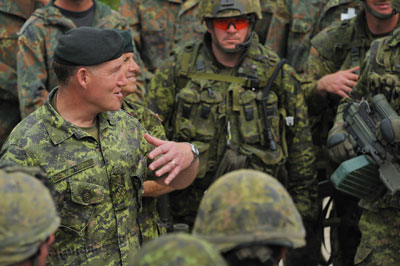
DND photo (Combat Camera) VL2010-0133-17 by Corporal Marc-André Gaudreault.
16 June 2010. General Walter Natynczyk, Chief of the Defence Staff, confers with soldiers about to be deployed or presently training at Camp Dubé, CFB Valcartier.
The Canadian Forces in 2010 and 2011 ~ Looking Back and Looking Forward
by General Walt Natynczyk
For more information on accessing this file, please visit our help page.
With the end of our combat operations in Kandahar this summer, and the transition to a new training mission in Afghanistan, 2011 promises to be another challenging year for the Canadian Forces (CF). As we prepare to make this transition, it is an opportune time to review what we have accomplished over the last year, and to outline what we need focus upon in the future.
Looking back on 2010, the CF can be proud of its accomplishments. It was a tremendously busy year from the standpoint of operational tempo. At one point in February, over 12,000 CF personnel were either deployed on operations, or were on exercise preparing for a deployment overseas.
At home, we made it clear that the security and defence of Canada is our priority mission, putting Canada first on search and rescue missions from coast to coast to coast; supporting other government partners at the Vancouver Olympic Games and the G8 and G20 summits; and conducting sovereignty operations in the Arctic. 2010 was also a year that demonstrated the strategic effect of Canada Command. Under its strategic leadership, our Joint Task Force commands gave us the structure, agility, and responsiveness to move out quickly whenever Canadians needed our support, as they did in Newfoundland in the wake of Hurricane Igor, or in Sarnia when a snowstorm stranded motorists on Highway 402.
Abroad, our mission in Afghanistan, our relief effort in Haiti, our counter-piracy operations off the Horn of Africa, and many other operations on the high seas and around the world brought great credit to Canada, and strengthened our reputation around the world that man-for-man, woman-for-woman, the Canadian Forces are second-to-none.
These experiences in Afghanistan and in other operations, such as counter-piracy missions off the Horn of Africa, have had another important impact; they have changed our culture. Today, we are a force with an operationally focused and agile culture. We have a much higher tolerance for risk that is enabled by the experiences we have amassed in a difficult combat operation. And it is this operational culture that gave us the ability to put ‘boots on the ground’ in Haiti to provide relief only a dozen hours after the government directed us to respond. It is this operational culture that also enabled our combat engineers to build a bridge in only a few days to reconnect the community of Trouty, Newfoundland.
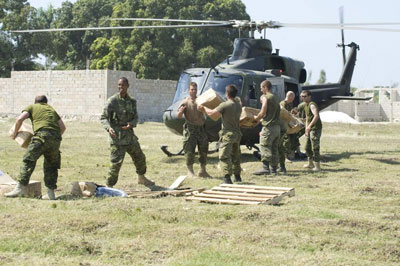
DND photo IS2010-5016-018 by Corporal Julie Belisle
Looking forward into 2011 and beyond, we need to build upon these successes and our operations-focused culture to ensure that the CF is ready for the future. To do so, I believe that we need to focus upon four areas:
- We must continue to succeed in our operations. This includes finishing the mission in Kandahar, drawing down our forces, and transitioning to a new training mission in Afghanistan;
- We must continue to transform, grow, and modernize the force. By this, I mean a number of interrelated initiatives. We must find efficiencies and opportunities for reinvestment that will make us a better fighting force. We must deliver on the Canada First Defence Strategy (CFDS) and recapitalize our major equipment fleets. We must institutionalize lessons learned that our recent experience in operations has shown to be vital in today’s operations, and we need to find space in our investment program for the capabilities that deliver or enable them. Finally, we need to build the capabilities and competencies that experience and judgement tells us will be vital in the future;
- We must look after our people. We need to ensure we have the right people, with the right experience, doing the right tasks. And we must continue to improve our support to military families, our ill and injured, and the families of the fallen. These are areas where we can always do better;
- And we must continue to connect with and be relevant to Canadians.
Operations
In Afghanistan, we will continue with our difficult mission in Kandahar until the summer of 2011, at which point we will turn over our area of responsibility to our NATO allies and begin the drawdown of our forces and material from Kandahar. At the same time, we will also begin the process of transitioning to a new training-focused mission, of which the centre of effort will be in Kabul.
Finishing our mission in Kandahar, drawing down our forces there, and transitioning to the new training mission constitute three major lines of effort in Afghanistan in the coming year. Let us be clear; this will not be easy. There is a lot to do. It will be difficult, and it will challenge all members of the Defence Team to ‘get it right.’
I have been asked many times about the future of the mission in Afghanistan, and I know that everyone would like the new mission to be spelled out in clear terms. With the recent decision of Government to transition to a training mission, we have only just begun our planning to sort the details of this new mission. We will examine where our contribution can have the greatest effect, and we are coordinating with our NATO allies to develop options for Government. In the end, Government will decide upon the specifics of the mission. What I can say is that:
- The new mission will involve a commitment of up to 950 CF personnel;
- It will focus upon training and building the capacity of the Afghan National Security Forces, which is a key facet of the NATO transition strategy;
- There will be no CF units located in Kandahar Province after 2011;
- The training mission will be focused on Kabul, but a small number of CF personnel may be assigned to other areas of Afghanistan, where the risk to our personnel is assessed to be less than or no greater than that found in Kabul;
- This training mission mandate will continue until 2014; and
- What we do in this mission will be pivotal to NATO’s ultimate ability to transfer responsibility for Afghan security to the Afghans.
There are many details to sort out with our NATO Allies and some key questions to resolve such as when this new mission will begin. Ultimately, these questions will have to be answered in the fullness of time.
Of course, we cannot permit the planning for the new mission to jeopardize our continued success in Kandahar. Everyone in the CF understands the importance of seeing the job through to a successful handover to our NATO allies in the summer of 2011. What I hear from our allies is that the Canadian Forces will be very difficult to replace.
To facilitate the drawdown of our forces from Kandahar, we have ‘stood up’ the Mission Transition Task Force. This task force will lead the difficult task of organizing our redeployment, including the disposition of materiel, facilities, stores, equipment, and resources. They will complete their work by the end of 2011.
Beyond Afghanistan, we will continue with our 14 other important missions around the globe. And, of course, we know that the future is unpredictable: 2010 demonstrated that we must always be ready for the unexpected. In 2011, there will be missions and tasks that we cannot predict today – some small, some large, but all important.
Transformation
Defence underwent a Strategic Review this year, calling for the elimination of five percent of the Department’s lowest priority and lowest performing activities.
The global economic downturn has put pressure upon all Western governments to reduce costs, and the Defence departments of our allies have all had to trim costs and find efficiencies. Canada is no different in this regard. That said, it is important to keep the strategic review in perspective. These constitute relatively modest adjustments to our budget, and overall, the total budget for Defence will continue to grow as we look to the future. More importantly, Strategic Review will not have an impact on our bottom line: namely, our ability to achieve mission success in the tasks assigned to us by Government in the CFDS.
We have gone through the process of identifying our lowest priority and lowest performing programs, and we will be examining how to implement these changes in the coming year.
In my view, the efficiencies we have found in Strategic Review reflect a wider need for continued transformation. As such, we created the post of Chief of Transformation in the summer to examine how we can achieve greater efficiency in our strategic and operational command and control structure and processes.
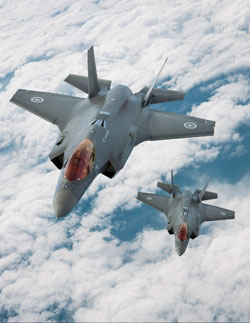
Lockheed Martin photo
A key component of transformation is the continued growth and modernization of the force as laid out in the CFDS. In some areas, like the air force, we have already achieved considerable success in recapitalizing our major equipment fleets. Historically, the air force has delivered an average of two new aircraft fleets into service per decade. This decade, we will deliver seven, including the Joint Strike Fighter - a fifth-generation fighter capability that will be essential to our operations in the decades to come. This is a monumental challenge, and I am proud of the way in which the air force and Defence team civilians have responded. In my view, this is another reflection of the operational culture we have forged in operations like those in Afghanistan.
In other areas, however, we continue to experience challenges. This is particularly true with respect to shipbuilding. Historically, warships are our most complicated and challenging capital acquisitions and because of this, shipbuilding remains my ‘Number One’ procurement priority. I am committed to ensuring that we continue to set the conditions so that we can move ahead and ‘cut steel’ to build the Arctic/Offshore Patrol Ships, and to replace our aging Auxiliary Oiler Replenishment (AOR) ships, destroyers, and, ultimately, the Halifax-Class frigates at the end of their service life.
In the army, we will continue with our recapitalization of vehicle fleets, but also ensure that we refurbish the equipment returning from Afghanistan so that it is ready for whatever mission may come next.
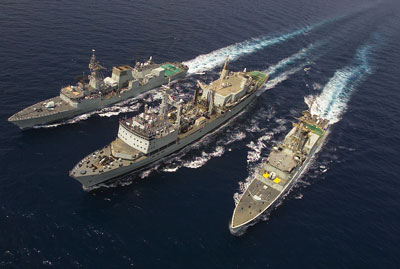
DND photo HS 2002-10260-03 from Combat Camera
Personnel
I am pleased the we have made such good progress in our recruiting goals, and that we have not only reached our force target of 68,000 regular force personnel, but that we have exceeded it by a small margin, thanks to an attrition rate that is the lowest it has been in decades. I am taking that as a positive sign that our people like what they are doing, and that they want to stay. Still, there are some challenges which we will have to face in the coming months.
First, we are overborne in some trades, in part because of our mission in Kandahar. With the mission in Afghanistan evolving to a training mission, we will begin to return to normal manning levels. We will also seek to continue returning some chronically under-strength and key technical trades across the CF to healthier levels, and to fill the gaps in our training and support structures. As much as we are able, I believe that we can recruit from within the Regular and Reserve Force to achieve much of this rebalancing, while natural attrition and recruiting intake will make up the difference.
Furthermore, with the addition of so many new recruits over the past few years, there remains a substantial gap between our manning levels and our trained effective strength. That said, it is encouraging that our trained effective strength is slowly rising. Closing the gap between Trained Effective Strength and Effective Strength will resolve many of the personnel shortage issues that some units continue to face.
Another impact of Afghanistan has been the increased number of reservists engaged on full-time, Class B service. With respect to our combat mission in Afghanistan, this has been a necessary and healthy situation. Many reservists are taking on full-time service to deploy on missions like Afghanistan, and many others are backfilling key positions on bases and staffs in Canada. With the change in our mission in Afghanistan, I anticipate that there will be less demand for Class B service. As we move forward, I will need Reservists on Class B service to focus their support upon the Reserves and Cadets, and to execute the Reserve Force operational missions.
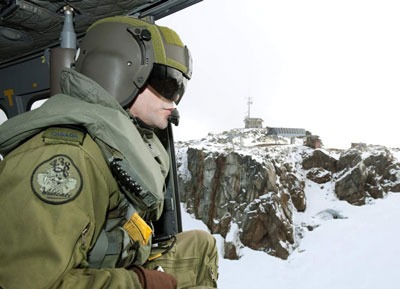
DND photo IS2009-9826 by Sergeant Frank Hudec, Canadian Forces Combat Camera.
In the same manner, I expect that the demand for contracted services will decrease. As we move forward, we will have to review, scrutinize, and rationalize our need for contractors in order to ensure that we optimize the resources that are available to deliver operational output.
We continue to make progress in how we care for our ill and injured, and we are realizing significant benefits from the Joint Personnel Support Units. They have proven their value, and I have been pleased with the positive reception they have received from those whom they support. Additionally, we appreciate the team effort conducted with Veteran’s Affairs, and the recent policy changes they have made to better support our wounded and veterans. These initiatives represent significant strides forward in ensuring that our injured will get the support they need after leaving the CF.
And we will keep working to improve our support to personnel suffering from PTSD and other mental health issues. I have been greatly encouraged by the significant progress we have made under the leadership of the Surgeon General, and I am confident that we are providing world class health care to those suffering from mental health issues. I am also pleased with the positive feedback we have received from soldiers, sailors, and air personnel who have gone through our decompression and reintegration programs in Cyprus. We need to continue building upon these improvements, and ensure that we approach mental health issues with understanding and compassion.
I expect all members to maintain a healthy life style, to achieve the standards for physical fitness that we have established, and to excel beyond the standards wherever possible.
We will also support our families, who are resilient and essential to our service to Canada. The operational tempo that we have all endured this past year has placed great strains upon them. As such, the support of the chain of command, the enabling resources of the Military Family Resource Centres, and mutual support that exists amongst them will hopefully mitigate the pressures of daily military family life. We owe them a debt of gratitude for their love, care, and support.
Closing Comments
There can be little doubt that coming year will be demanding. In operations, we will finish our combat mission in Kandahar, drawdown our forces, and begin the training-focused mission that will be key to NATO’s plans to transition responsibility for security to the Afghans themselves. We will continue to transform the force, and focus upon maximizing our resources to deliver more operational output. And we will keep working to improve the way we care for those who have sacrificed so much for their country. But I am confident that the CF is up to these challenges. We have great, motivated people in the CF who believe in what they are doing, and believe that they are making a difference in the world. The same can be said of the civilians in the Defence team, and the families who enable our operations and success. With great people, great things are achievable.
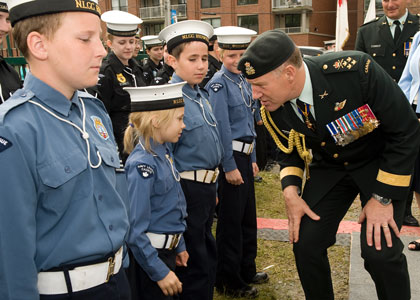
DND photo HS2009-0315-034 by Master Corporal Robin Mugridge.
![]()
General Walter Natynczyk, CMM, CD, is a highly experienced soldier who has commanded at all levels. He is currently Chief of the Defence Staff (CDS) of the Canadian Forces.






